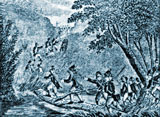|
|
|
|
|
|
|
|
|
|
Camp Colour Scottish Dirk Militia Officer's Gorget Badge of Loyalty Loyalist Uniform 
Camp Colour
Royal Highland Emigrants CWM 18950002-004
Camp Colours marked the streets in British army campsites so that the soldiers
from each regiment would know where to pitch their tents.
Recruited in North America in 1775, the Royal Highland Emigrants played a
leading role in the defence of Quebec City.

Scottish Dirk
around 1775 CWM 19800027-001
Scottish soldiers carried long daggers known as dirks. This one belonged to
John Nairne of the Royal Highland Emigrants. Nairne was one of the soldiers at
the Sault-au-Matelot Barricade who climbed the ladder into a house occupied by
the Rebels.

Militia Officer's
Gorget
Quebec Militia CWM 19790001-008
Officers wore gorgets as a badge of rank. The markings on this gorget
commemorate the successful defence of Quebec City in 1775-1776.

Badge of Loyalty
Pouch Plate, Butler's Rangers CWM 19800978-399 Loyalist soldiers wore badges bearing a crown and the
King's initials. The G.R. on this cartridge box plate stands for
Georgius Rex,
Latin for King George. George III was King of Great Britain during the American
Revolution.

Loyalist Uniform Officer's Coatee, Light Infantry Company CWM 19830092-001 Officer's Breeches, Light Infantry Company CWM 19830092-002 Officer's Waistcoat, Light Infantry Company CWM 19830092-002 In 1779, Loyalist soldiers received scarlet uniforms, similar to those worn by British regulars. This one belonged to Lieutenant Jeremiah French of the King's Royal Regiment of New York. The gold buttons bear the regiment's initials. They are arranged in pairs to indicate that French belonged to the 2nd battalion of the regiment. This is one of the oldest complete uniforms in Canada. |
|||||||||||||||||||||||||||||||||||||||||||||||||||||||||||||||||||||||||||||||||||||||
